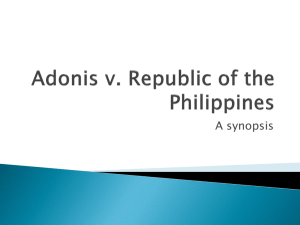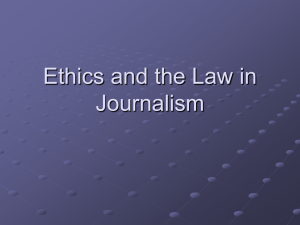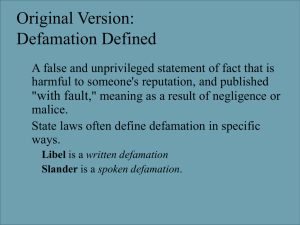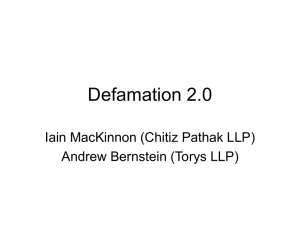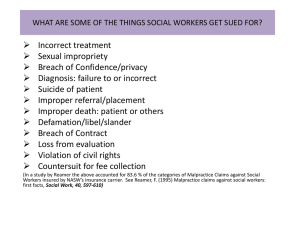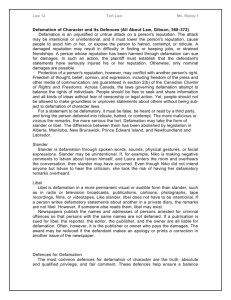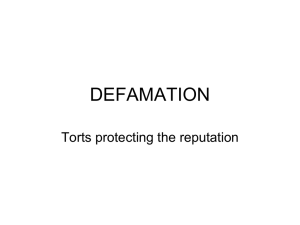download. - Applied Crypto Group at Stanford University
advertisement
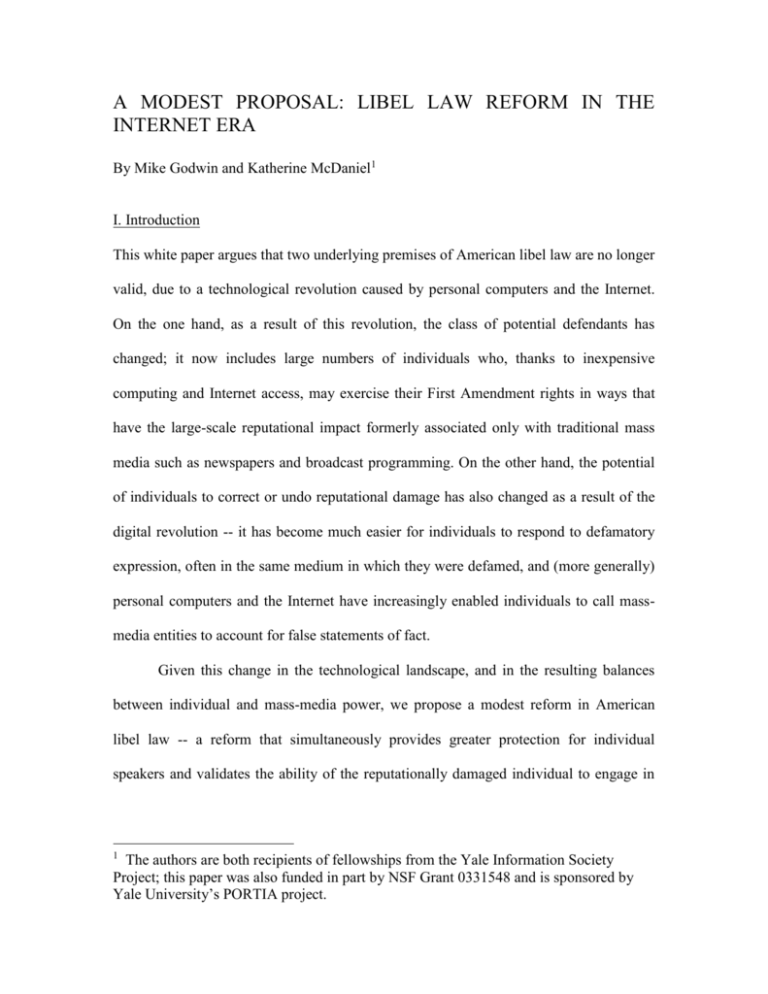
A MODEST PROPOSAL: LIBEL LAW REFORM IN THE INTERNET ERA By Mike Godwin and Katherine McDaniel1 I. Introduction This white paper argues that two underlying premises of American libel law are no longer valid, due to a technological revolution caused by personal computers and the Internet. On the one hand, as a result of this revolution, the class of potential defendants has changed; it now includes large numbers of individuals who, thanks to inexpensive computing and Internet access, may exercise their First Amendment rights in ways that have the large-scale reputational impact formerly associated only with traditional mass media such as newspapers and broadcast programming. On the other hand, the potential of individuals to correct or undo reputational damage has also changed as a result of the digital revolution -- it has become much easier for individuals to respond to defamatory expression, often in the same medium in which they were defamed, and (more generally) personal computers and the Internet have increasingly enabled individuals to call massmedia entities to account for false statements of fact. Given this change in the technological landscape, and in the resulting balances between individual and mass-media power, we propose a modest reform in American libel law -- a reform that simultaneously provides greater protection for individual speakers and validates the ability of the reputationally damaged individual to engage in 1 The authors are both recipients of fellowships from the Yale Information Society Project; this paper was also funded in part by NSF Grant 0331548 and is sponsored by Yale University’s PORTIA project. LIBEL LAW REFORM PROPOSAL (March 2007), Page 2 self-help that will be both less expensive and more satisfying than the traditional libel lawsuit. Our suggestion for reform centers on the ability of modern publishers on the Internet (e.g., The New York Times, Salon, Slate, and other, smaller publishers who offer all or most of their material online) to provide an online right of a reply to those who believe they have been injured by defamation. Although we do not propose that such publishers be compelled to offer such a right of reply, we believe that incentives to do so would both survive constitutional scrutiny and serve the important public interest of promoting a less costly, more accessible remedy for reputational damage. It is important at the outset that we not be understood as arguing that an online right of reply, in any form, is necessarily an adequate remedy in all cases. We believe, however, that such a right of reply may well be an adequate remedy in many cases, and as such would be preferable to (generally costly) defamation litigation and to the risk that such litigation might chill the dramatic growth of First Amendment-protected expression in the online world. We further believe that the adequacy of an online right of reply to remedy reputational damage may require case-by-case factual inquiry. We note also that, to some extent, the potential chilling effect in the online world has been lessened by Section 230 of the Communications Decency Amendment to the omnibus federal Telecommunications Reform Act of 1996. That provision exempts online publishers from liability for defamatory content they did not originate. (The most obvious example of such content may be a defamatory posting by an angry reader to a newspaper’s unmoderated online forum; under Section 230 the newspaper is exempt from liability.) But this exemption, important as it is, does not provide any protection to LIBEL LAW REFORM PROPOSAL (March 2007), Page 3 the online publisher for content the publisher originates, and in the modern era that content may be originated by anyone from a major newspaper to an individual blogger or website operator. It is in large part because of the lack of affordable legal protections for many of the latter class of publisher -- a class that is nominally just as protected by the First Amendment as the The New York Times or the Wall Street Journal -- that we raise here the possibility of a narrowly crafted reform of libel law based on the provision of a right of reply. II. Discussion American libel law has long been understood as providing a set of remedies for the wrongful reputational damage that can be caused by mass media. Because these remedies may have the effect of chilling mass media’s exercise of its rights under the First Amendment, however, the U.S. Supreme Court has chosen over the last several decades to alter defamation law. These alterations, starting with with The New York Times Co. v. Sullivan (1964) have provided more protection for speech and press by making it more difficult for certain plaintiffs to prevail in libel lawsuits. In Sullivan and its progeny, the law was altered in two distinct waves. First, the Court in Sullivan expressly constitutionalized defamation law by crafting new balances in libel law that explicitly accommodated longstanding First Amendment interests. Specifically, Sullivan both (a) distinguished between private plaintiffs and public officials, and (b) required that public officials prove “actual malice”2 on the part of the defendant in order to prevail. Second, in a series of cases, the Court expanded the category of those who must prove “actual malice”, by including more types of public “Actual malice” is a term of art in American libel law; in effect, this term means “knowing falsehood or reckless disregard of the truth.” 2 LIBEL LAW REFORM PROPOSAL (March 2007), Page 4 officials, then by broadening the category to include public figures, and finally by including a new kind of public-figure: public figures for a limited purpose.3 But despite these recent decades of adaptation, defamation law still does not mirror the current political reality. The end of last century and the early years of the present one have brought technological changes in communicative capacity to which the law has been notoriously slow to adapt. The early cases dealing with the Internet and defamation focused on the status of the Internet service providers (ISPs) whose users posted the defamatory statements. Congress recognized that if ISPs were treated like publishers or distributors of libel, then they would be potentially libel for thousands of defamation suits <Probably needs a footnote commenting on the tendency of Internet users to fling words around>. Thus, Congress sought to protect ISP and thus promote their proliferation by granting them immunity from certain kinds of lawsuits. This immunity took the form of Section 230 of the Communications Decency Act, the so-called “safe harbor provision,” the relevant portion of which reads: (c) Protection for "Good Samaritan" blocking and screening of offensive material. (1) Treatment of publisher or speaker. No provider or user of an interactive computer service shall be treated as the publisher or speaker of any information provided by another information content provider. (2) Civil liability. No provider or user of an interactive computer service shall be held liable on account of-(A) any action voluntarily taken in good faith to restrict access to or availability of material that the provider or user considers to be obscene, lewd, A third wave of alteration may be the line of Supreme Court cases moving the distinction between “fact” and “opinion” from a bi-valent dichotomy to a continuum. This has meant that where published expressions of mere opinion once had near-categorical protection, such expressions now may create defamation liability where they incorporate or even merely imply false statements of fact. This development significantly expands the potential scope of liability for, e.g., bloggers, who may or may not be focused on making factual assertions, but who routinely engage in expressions of opinion. 3 LIBEL LAW REFORM PROPOSAL (March 2007), Page 5 lascivious, filthy, excessively violent, harassing, or otherwise objectionable, whether or not such material is constitutionally protected; or (B) any action taken to enable or make available to information content providers or others the technical means to restrict access to material described in paragraph (1) [subparagraph (A)]. (d) Obligations of interactive computer service. A provider of interactive computer service shall, at the time of entering an agreement with a customer for the provision of interactive computer service and in a manner deemed appropriate by the provider, notify such customer that parental control protections (such as computer hardware, software, or filtering services) are commercially available that may assist the customer in limiting access to material that is harmful to minors. Such notice shall identify, or provide the customer with access to information identifying, current providers of such protections. After the passage of the Communications Decency Act 4, cases regarding defamation on the Internet—cases like Zeran v. America Online, Inc., 129 F.3d 327 (4th Cir. 1997) Blumenthal v. Drudge, 992 F. Supp. 44 (D.D.C. 1998)—focused on the defendant ISPs qualified for the section 230 safe harbor. In deciding these cases, the courts did not the theoretical underpinnings of libel law. Unlike Sullivan and its progeny, the courts in deciding these cases did not frame the policy question as one of balancing the promotion of free speech against the need to protect private reputation. Nor did the courts seek to balance the promotion of technology and the spread of Internet access against the need to protect private reputation. Instead, these cases focus primarily on statutory interpretation of Section 230. Section 230, however, was crafted with the goal of supporting the growth of Internet services by shielding them from liability for content the services did not originate. Not entirely incidentally, Section 230 has had the effect of promoting freedom of expression on the Internet, since its safe harbor frees Internet services from liability for 4 Much of the Communications Decency Act was struck down as unconstitutional by the U.S. Supreme Court in Reno v. ACLU (1997) but Section 230, quoted supra, was unchallenged by the plaintiffs in that case and remains in place. LIBEL LAW REFORM PROPOSAL (March 2007), Page 6 the defamatory expression of non-agent subscribers and other users. We believe, however, that more can be done to adjust the libel-law framework in ways that can promote First Amendment values while reinforcing the prerogative of those who are defamed to correct the record. We believe it is time to revisit libel law once again, and adapting the reasoning of Sullivan and its progeny to a new set of circumstances, strike a better balance in our law between freedom of expression and the need to remedy private harms. Specifically, we propose the creation of safe harbor for online authors, distributors, and publishers who give alleged victims of defamation a right of reply. For those parties, the public/private figure distinction would abolished, and all defamation plaintiffs would be subject to the Sullivan “actual malice” test. We first explain why such a new safe harbor is necessary and then explain the details of the proposal. A. The Logic of a Safe Harbor Based on a Right to Reply The Sullivan line of cases is premised on the proposition that, in cases of defamation, self-help is the preferred remedy.5 In the case of defamation, that would take the form of rebutting the alleged defamatory speech -- publishing the truth in a way that corrects the record and undoes any reputational damage. Public officials and public figures normally have greater access to media channels than private individuals have -- to put the matter succinctly: when a public official or public figure holds a press conference to challenge a purportedly defamatory statement by a traditional publisher, reporters are likelier to show up. Historically, however, the ability to engage in self-help has been considered less than effective if the defamatory speech is 1) widely published; 2) to a 5 For a similar sentiment, expressed in another line of First Amendment cases, see Brandeis, J., in Whitney v. California (1927): "If there be time to expose through discussion the falsehood and fallacies, to avert the evil by the processes of education, the remedy to be applied is more speech, not enforced silence." LIBEL LAW REFORM PROPOSAL (March 2007), Page 7 widely dispersed audience; 3) by a significant media source; 4) to which the plaintiff has little or no access or power of persuasion. Under these circumstances, a plaintiff may find the prerogative to engage in self-help less than satisfying and so may choose to turn to the courts. Yet, while causes of action in libel provide a useful alternative avenue for redress for individuals when self-help is inadequate, the law should also recognize that such causes of action may chill important expression as well, especially in an era in which digital technologies empower individuals to speak more widely and effectively than ever before.6 While Section 230 of the Communications Decency Act does much to protect corporate defendants (including both carriers and traditional mass-media publishers) -and incidentally to promote individual freedom of speech by eliminating any need for carriers or publishers to censor independently generated content -- it does not directly protect individual speakers. We take the view, however, that individual freedom of expression deserves at least as much protection as that of traditional media defendants. What we propose, therefore, is a reform of libel law that better balances the protection of individuals from reputation harm with the promotion of individual free speech. We base our proposal on the reasoning that underlies the outcome in The New York Times Co. v. Sullivan -- that our libel-law framework protects important freedom-of-expression interests by making it more difficult for certain plaintiffs (those with the ability to utilize mass media) to prevail. That is, the law continues to give strong protection to private 6 Prior to the Internet era, one might reasonably think that the First Amendment protected one set of freedom-of-expression rights for individuals (speech) and another for mass-media entities (press). The scope that Internet publication gives individual citizens to engage in freedom of expression, however, may be said to have made the two sets of rights coterminous, or at least potentially so. LIBEL LAW REFORM PROPOSAL (March 2007), Page 8 individuals while encouraging “public” persons -- in other words, those who have access to the media -- to engage in self-help as opposed to legal action. The assumption that only public officials and public figures can have sufficient access to mass media to correct an instance of defamation made sense under the twentieth-century model of mass media—that is, when defamation is published by a newspaper, a magazine, a broadcaster, a cable network, or similar traditional publisher. But the communication that takes in cyberspace can be quite different from the traditional model of one-to-many publishing or broadcasting and the kind of the communication that takes place there7. B. A Case Study: Blumenthal v. Drudge “Internet on Trial” was how Vanity Fair’s December 1997 issue billed its report on the lawsuit against Matt Drudge, the Internet’s first political gossip columnist. What was really on trial, however, was not the Internet itself, but the usefulness of libel law itself. Drudge, now 40, is a news junkie who decided to become a gossip columnist and, thanks to the Internet, succeeded beyond his expectations, if not beyond his wildest dreams. Starting from scratch in 1995, Drudge has built up a massive subscriber list and in the mid-1990s won a substantial if not princely contract with America Online to publish his online newsletter there as well. In the late 1990s, he blazed a meteoric path— becoming, increasingly, a frequently read source for political journalists, if not always a well-respected one. 7 We do not dispute that one-to-many communication can take place in cyberspace as well as in other media. See, e.g., the Wall Street Journal’s website at http://online.wsj.com/public/us. Our point here is that one-to-one and many-to-many publication can take place in cyberspace as well, and in fact the latter is the norm on the World Wide Web. LIBEL LAW REFORM PROPOSAL (March 2007), Page 9 But whatever Drudge’s dreams of success at Internet journalism, he almost certainly didn’t anticipate the nightmare of a $30 million lawsuit. And that’s precisely the amount of reputational damage White House aide and former journalist Sidney Blumenthal is claiming that Drudge (and America Online, which subsidized and carried Drudge) did to him when the online columnist published an item suggesting that Blumenthal has a history of spousal abuse. (Specifically, the item said conservative operatives were planning on exploiting a record of spousal abuse they claimed Blumenthal had—but, as I noted at the beginning of this chapter, merely repeating a false claim can make the person who repeated it just as legally responsible as the person who originated it.) And, as it turned out, Drudge’s report, which was based on information from an undisclosed source, added up to a falsehood—there is no known evidence that Blumenthal ever engaged in anything like domestic violence with regard to Jacqueline Jordan Blumenthal, who at the time of Blumenthal's appointment and Drudge's publication of the item headed the White House Fellowships Commission. Tellingly, Blumenthal read the Drudge item on the evening of the day it was released—illustrating either the immediacy of Internet news or Drudge’s must-read status or both. (Jacqueline Blumenthal received a faxed copy of it from a former congressional press secretary the following morning.) Understandably incensed, Blumenthal had his lawyer, William McDaniel, send what Vanity Fair called a “strongly worded” letter to Drudge, who, after quickly discovering that he could not verify his original story, published an apology and a retraction. Unsatisfied with this response, Blumenthal filed a libel lawsuit against Drudge and America Online, seeking an improbable $30 million in damages. LIBEL LAW REFORM PROPOSAL (March 2007), Page 10 Setting aside the question of whether Blumenthal is a public figure, there remains the issue of whether Blumenthal ultimately suffered any damage to his reputation at all— much less $30 million worth. (I won’t dispute that Blumenthal found Drudge’s false story personally painful—he and his wife surely did. But the very raison d’être of libel law is damage to reputation, not to one’s personal psychological well-being. That’s why “publication”— the showing of the defamatory statement to a third party—is the sine qua non of libel cases: you can’t have committed a libel merely by hurting someone’s feelings privately.) We can start by reminding ourselves that Drudge quickly retracted his false report and apologized for it—more than once, as it happens, and in more than one place. (Newspapers and broadcasters have no equivalent means of retraction.) This means that, at the very least, the same readership that saw the original erroneous report saw its retraction, which ought to be enough to reduce the reputational damage—whatever it might have been—to a significant degree. But that can’t be the end of the inquiry, since Drudge’s retraction, and Blumenthal’s announcement of the $30 million lawsuit, were immediately reported and discussed all over the Internet to an audience far broader than Drudge’s core subscribers. What’s more, it was a headline grabber in lots of traditional media as well, including a story in The Wall Street Journal and multiple stories in The New York Times. This raises a central question for the case: Is there anyone at all who knows a) who Blumenthal is, and b) what Drudge originally wrote about him, who does not also know c) that Drudge totally retracted his story? The answer to this question is almost certainly a solid “No.” LIBEL LAW REFORM PROPOSAL (March 2007), Page 11 That answer might be different if Blumenthal were a public figure as widely known as, say, Bill Clinton—or even Conan O’Brien. But Blumenthal is well-known only in those circles that pay attention to bylines in The New Republic or Salon.com—and you can bet that to anyone with whom Blumenthal even has a reputation, Drudge’s flat retraction is already old news. In other words, this is one case in which the media—both old and new—have functioned just the way they’re supposed to in an open society—and just the way some First Amendment theorists always argued that freedom of speech and press should operate. Drudge’s correction has caught up with, and even outpaced, the original defamation. Moreover, the record was corrected, and Blumenthal’s reputational damage reversed, because of what happened on the Internet -- including Drudge’s removal of the original Blumenthal item and his posted retraction of that item, and not because of the lawsuit. which ultimately was settled on terms unfavorable to Blumenthal.8 C. The Declining Significance of Libel Law’s Public Figure Doctrine Of course, Blumenthal’s success in obtaining a remedy for his reputational damage despite an unsuccessful lawsuit may be attributable to Blumenthal’s status as a public figure. Current and emerging technologies, however alter the essential premises upon which the logic of libel law’s public-figure/private-individual distinction is built. The victims of online defamation today have far greater access to self-help (making legal resolution less necessary) than even Blumenthal had. Moreover, individuals who would 8 Blumenthal originally sued both Drudge and America Online, which carried Drudge’s column. AOL successfully invoked Section 230 and was dropped as a co-defendant. The case lingered for a few years until Blumenthal, tired of the legal fees associated with pursuing the case, decided to settle it on terms favorable to Drudge (Blumenthal paid $2500 to Drudge’s attorneys). LIBEL LAW REFORM PROPOSAL (March 2007), Page 12 might otherwise be considered private figures now can use websites, blogs, and other Internet applications to “thrust themselves into the vortex” of public debate. In addition to these altered assumptions, expression in cyberspace also differs from that in the physical world in that the corrected text can actually replace the original defamatory text, rather than appearing in a temporally and spatially separated medium. Finally, it’s true that if defamatory speech is posted on one of more popular blogs— the Kausfiles or AndrewSullivan.com, for example—then it will be widely distributed. But the same would be the case for any reply or retraction on the same blogs.9 We may infer from a study of the characteristics of online speech, together with a review of relevant passages in the Sullivan line of cases that, to some extent at least, a large number of individuals using the Internet who might have been classified as private figures in traditional libel contexts are more like public figures on the Internet. Consider: (1) In Gertz v. Robert Welch Inc. (1974), the Court emphasized not only the power-disparity between private individuals and big media, but also the normative diference between libel plaintiffs who have sought out the lime light and those that have been dragged into it: More important than the likelihood that private individuals will lack effective opportunities for rebuttal, there is a compelling normative consideration underlying the distinction between public and private defamation plaintiffs. An individual who decides to seek governmental office must accept certain necessary consequences of that involvement in public affairs. He runs the risk of closer public scrutiny than might otherwise be the case…Those classed as public figures stand in a similar position. Hypothetically, it may be possible for someone to become a public figure through no purposeful action of his own, but the instances of 9 On the other hand, if defamatory speech is published on a smaller blog, even though fewer people will read it, arguably the impact of that defamation may sometimes still be significant if the smaller blog is routinely read by a community of the defamee’s peers. LIBEL LAW REFORM PROPOSAL (March 2007), Page 13 truly involuntary public figures must be exceedingly rare. For the most part those who attain this status have assumed roles of especial prominence in the affairs of society. Some occupy positions of such persuasive power and influence that they are deemed public figures for all purposes. More commonly, those classed as public figures have thrust themselves to the forefront of particular public controversies in order to influence the resolution of the issues involved. In either event, they invite attention and comment. Communication on the Internet has been praised precisely because it gives individuals a platform from which they can, at least attempt to, “influence the resolution” of “particular public controversies.” (2) Nor was the Gertz Court breaking much new ground in discussing the blurring of the public-figure/private-individual disinction -- even in 1967, in Curtis Publishing Co. v. Butts, the Court had already noted that the public-private line was blurred: Increasingly in this country, the distinctions between governmental and private sectors are blurred…[Power has] become much more organized n what we commonly considered to be the private sector. In many situations, policy determinations which traditionally were channeled through formal political institutions are now originated and implemented through a complex array of boards, committees, commissions, corporations, and associations, some only loosely connected with the Government. This blending of positions and power has also occurred in the case of individuals so that many who d not hold public office at the moment are nevertheless intimately involved in the resolution of important public questions, or by reason of their fame, shape events in areas o concern too society at large. [Such persons] often play an important role in ordering society…our citizenry has a legitimate and substantial interest in the conduct of such persons, and freedom of the press to engage in uninhibited debate about their involvement in public issues and events is as crucial as it is in the case of “public officials.” --Curtis Publishing co. v Butts, 388 I.S. 130, 135-37 (1967). In other words, the Court was recognizing that the distinction between public officials and public figures isn’t a hard and fast one. But the line between public and private affairs, and public and private figures, is even blurrier in realm of cyberspace. Recall that in Gertz the Court noted that a key LIBEL LAW REFORM PROPOSAL (March 2007), Page 14 distinction between so-called public figures are distinguished from private individuals by virtue of their ability to get their stories out via mass media? It follows from this reasoning that on the Internet, where individuals potentially have at least some ability to correct the record (and perhaps a very great ability indeed), this distinction is even harder to maintain. It is precisely because the scope of individuals’ ability to respond is inherently greater on the Internet that we call here for a privilege associated with a forum’s giving the alleged defamee the ability to respond fully and correct the record.10 III. The Proposal in Full What we propose is a legislatively created “safe harbor” similar to that of Section 230 of the Communications Decency Act, but broader in scope. Congress would enact a safe harbor for online authors, distributors, and publishers who give alleged victims of defamation a right of reply. For those parties, the public/private figure distinction would abolished, and all defamation plaintiffs would be subject to the Sullivan actual malice test. The relevant portion of the proposed legislation would read: Protection for giving a right of reply. (1) Treatment of publisher or speaker—No online authors, distributors, publishers, shall held liable for defamation on account of (A) any action voluntarily taken in good faith to remove material that the provider or user considers to be defamatory, whether or not such material is constitutionally protected; or We acknowledge at the outset that even when a forum doesn’t provide any right of reply to an aggrieved individual, that individual may well have significant ability to publicize his or her side of the story via other venues on the Internet. Nothing we propose here undercuts that prerogative. Because the original venue may reach particularly large or uniquely important audience, however, we believe it is important to encourage -though not require -- forums to provide opportunities for individuals to correct the record when they believe they have been misrepresented. 10 LIBEL LAW REFORM PROPOSAL (March 2007), Page 15 (B) any action taken to enable alleged victims of defamation to rebut or make available information rebutting the alleged defamatory statements.. Provided that the statement or statements at issue were not published with actual malice. (2) Obligations of interactive computer service—Online authors, distributors, publishers, shall, in a conspicuous manner deemed appropriate by the provider, post: (A) a notification that victims of alleged defamation have a right of reply; and (B)provide information on how to use that right of reply. (3) Effect on Other Laws (A) No Effect on Intellectual Property Law—Nothing in this section shall be construed to limit or expand any law pertaining to intellectual property. (B) State Law—Nothing in this section shall be construed to prevent any State from enforcing any State law that is consistent with this section. No cause of action may be brought and no liability may be imposed under any State or local law that is inconsistent with this section. (C) No Effect on Communications Privacy Law—Nothing in this section shall be construed to limit the application of the Electronic Communications Privacy Act of 1986 or any of the amendments made by such Act, or any similar State law. (D) No effect on the safe harbor provisions of Section 230 of the Communications Decency Act (E) No effect on civil actions brought for other right to privacy or right to publicity torts. Under the new law, “Online authors” would include: 1) Authors of content placed on self-owned, self-created, and selfmanaged websites. LIBEL LAW REFORM PROPOSAL (March 2007), Page 16 2) Authors of content placed on webpage created and maintained by the author, but ultimately owned by a third party. For example, authors of blogs hosted on Blogger or Typepad. and authors of material posted on their own Myspace or Facebook pages. 3) Authors of content placed on websites owned and managed by third parties. For example, the author of a comment placed on a blog owned or managed by someone else. The right of reply could take one of several forms. For static, non-interactive web pages, the right of reply could take the form of external or internal links. An external link would allow the subject of the defamatory speech (the would-be plaintiff) to link to a webpage of his or her own creation that would contain a rebuttal of, or response to, the defamatory speech. An internal link would point to a part of the defendant’s website where the subjects of defamatory speech would be allowed to make a rebuttals or responses. For dynamic or interactive websites, such as blogs, or Myspace or Facebook pages, a publicly available comments section would suffice, so long as the comment-space followed immediately after the post or section containing the allegedly defamatory speech.11 IV. Conclusion. In conclusion, the authors wish to remind readers first and foremost of the extent to which the proposal outlined above is evolutionary rather than revolutionary. Consider, for example, that this proposed reform is limited to defamation -- it would not affect are the myriad of other common law torts often used in conjunction with defamation suits, such as invasion of privacy, false light misrepresentation, tortuous interference with business opportunity, unfair competition, and intentional infliction of emotional distress. 11 It is important to distinguish what we propose here from any proposal that would mandate, rather than merely encourage, that a forum provide a right of reply. A flat mandate, we believe, would be unconstitutional if applied to a non-broadcasting forum. See Miami Herald Publishing Co. v. Tornillo (1974). LIBEL LAW REFORM PROPOSAL (March 2007), Page 17 Moreover, the proposed reform would also not affect statutory rights of action such as anti-harassment provisions, anti-hate speech provisions, or laws that regulate threatening speech or speech that incites violence. Nor does our proposal, in essence, aim to abolish the tort of defamation; instead, it merely changes the standard of liability in a way that would both provide greater protection for smaller publishers and a better range of remedies for injuried parties.. Under this proposal, any plaintiff suing for defamatory speech on the Internet is merely subject to the same standard as public official suing for defamatory speech in all media. Under that standard, defendants who can be shown to have “actual malice” in their publication can still be successfully sued for defamation as well as for other communications torts such as those listed in the preceding paragraph. So (for example) when the defendant knowingly makes a false statement, the plaintiff may still recover damages even though the defendant may have provided the plaintiff a right of reply. That said, this proposal is designed to serve a particular pair of significant substantive goals: (1) providing greater protection for online publishers who may not be able to afford to mount the legal and Constitutional defenses they are entitled to invoke, and (2) encouraging such publishers to operate their online offerings in ways that allow reputationally injured parties to engage in self help to correct the record rather than be required to invest in legal action in order to do so. The authors believe that not every balancing of rights in the freedom-of-expression arena is a zero-sum game -- we offer here a modest reform that benefits would-be plaintiffs and defendants who otherwise might be forced unwillingly to seek less satisfactory solutions in the courts. LIBEL LAW REFORM PROPOSAL (March 2007), Page 18 AUTHORS’ NOTE: This paper was funded in part by NSF Grant 0331548 and has received support from Yale University’s PORTIA project.
